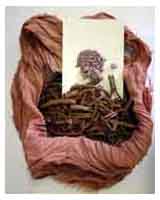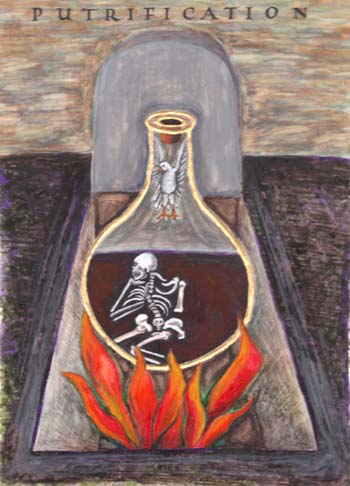Please join our email list to be notified of the book being published and other illumination related topics.

Unlocking
the Secrets of
Medieval Painters and Illuminators
ABOUT THE PIGMENT CHAPTER:
Recipes for making over 50 pigments from scratch, lightfastness tests, pigment interaction tests and much more including the relationship between early alchemists and color recipe development and the alchemical spiritual meaning behind the different chemical processes.
EXCERPT: Madder Root
 Imagine saffron aroma, stewing plants, and the scent of
fresh squid. Hear stone grinding against stone, leaves being crushed and the
excited chatter of apprentices learning their next task. Breathe in the bitter
aloe flavor and taste it at the back of your throat. See stones of brilliant
green and deep blue, herbs hanging upside-down to dry, mussel shells filled with
puddles of rich red and clear yellow paint, and over against the wall a row of
desks with projects in various states of completion. Need a specific greenish
yellow for your new painting? You grab the bunch of dried weld hanging on the
wall and put it to boil.
Imagine saffron aroma, stewing plants, and the scent of
fresh squid. Hear stone grinding against stone, leaves being crushed and the
excited chatter of apprentices learning their next task. Breathe in the bitter
aloe flavor and taste it at the back of your throat. See stones of brilliant
green and deep blue, herbs hanging upside-down to dry, mussel shells filled with
puddles of rich red and clear yellow paint, and over against the wall a row of
desks with projects in various states of completion. Need a specific greenish
yellow for your new painting? You grab the bunch of dried weld hanging on the
wall and put it to boil.
This
is the spectacular world available to the artist who knows traditional recipes
and techniques. For a greenish yellow, weld might be the perfect choice.
But for a bright transparent yellow, saffron would clearly shine. The expanded
variety of colors with their
individual hues, textures, and working properties
can give artists the technical edge to fulfill
their personal visions. Making
pigments also creates such an intimate relationship to colors
that the very
notion of what “blue” is, for example, can be transformed as the artist becomes
connected to the essence of blue in a new and exciting way. This intimacy is at
a far removed from going to an art supply store to buy a tube of paint. With
limited color choices, homogenized working properties and the x-factor,
invisible extenders and additives, an artist can never be sure what a paint
manufacturer is selling. In the plastic shopping bag the paint tubes knock
together with a dull thud. It is like buying a carton of milk, instead of
milking a cow. The scents, the textures and the beauty of the farm are gone.
We are living in a time of great revival in traditional methods and materials. Although tube paints are the norm in art supply stores, lately it has become noticeably easier to find the raw materials for traditional paints. By combining these ancient techniques with recent research, an artist has more power and possibility to create than ever before in the history of art.
PARTIAL LIST OF PIGMENT
RECIPES INCLUDED IN THE
PIGMENT CHAPTER:
 Almond
Shells, Azurite, Azurite/Malachite, Bistre, Bone Black, Bone White, Brazilwood, Burnt Ocher, Burnt Sienna, Cabbage, Chalks, Chrysocolla, Cinnabar, Clays, Cochineal, Flower Petals, Fustic, Hematite, Honey Green, Jasper, Indigo, Ivory Black, Kermes, Lac, Lapis Lazuli, Leather, Leeks, Linseed Oil, Logwood, Madder, Malachite, Massicot, Peach Pit Grey, Red Lead, Rue, Salt Green, Safflower, Saffron, Sap Green, Silver Blue, Soap Green, Spinach, Tiger’s Eye, Turmeric, Verdigris, Vermillion, Vine Black, Vivianite, Weld, Woad, White Lead
Almond
Shells, Azurite, Azurite/Malachite, Bistre, Bone Black, Bone White, Brazilwood, Burnt Ocher, Burnt Sienna, Cabbage, Chalks, Chrysocolla, Cinnabar, Clays, Cochineal, Flower Petals, Fustic, Hematite, Honey Green, Jasper, Indigo, Ivory Black, Kermes, Lac, Lapis Lazuli, Leather, Leeks, Linseed Oil, Logwood, Madder, Malachite, Massicot, Peach Pit Grey, Red Lead, Rue, Salt Green, Safflower, Saffron, Sap Green, Silver Blue, Soap Green, Spinach, Tiger’s Eye, Turmeric, Verdigris, Vermillion, Vine Black, Vivianite, Weld, Woad, White Lead
Alchemist's Symbol
by Sybil Archibald
View Other Chapters From Lapis & Gold:
The Pigment Almanac (A reference guide to pigments)
Contact us for more information
(c) 2006-9
Sybil Archibald &
Karen Gorst
All material on this website is copyrighted and may not be used without
permission.
